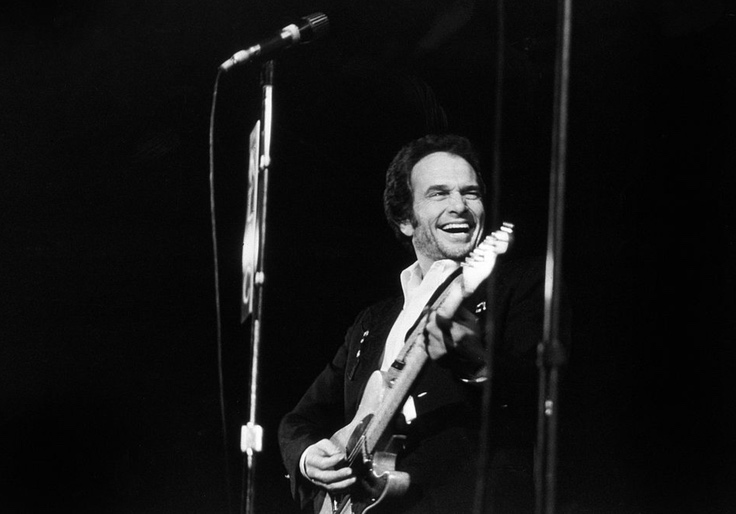Johnny Cash's 1968 live album, At Folsom Prison, revitalized the Man in Black's career, but it was his New Year's Day performance years earlier at San Quentin, another notorious California state prison, that captivated a wayward, would-be country star. Merle Haggard, then the 22-year-old inmate number A-45200 serving a 15-year sentence for repeated arrests and escapes, would credit Cash's jailhouse concert as an inspiration to pursue a career in music.
Backed by his band The Strangers, Haggard would go on to produce nine gold- or platinum-certified albums and 38 Billboard number-one country songs—including a number-one or -two hit single every four months in the late 1960s. But as he challenged the Nashville country music orthodoxy, he never quite crossed over into definite mainstream success. As such, Merle Haggard's legacy—in life and as a singer-songwriter—is too often reduced in the wider popular culture to a cursory familiarity with only a few mega-hits.
It is Haggard's depth and complexity that Marc Eliot, a prolific biographer, explores in The Hag: The Life, Times, and Music of Merle Haggard.
Born in 1937 in Bakersfield, California, Haggard was the son of working-class "Okies" who relocated during the Great Depression. His father's sudden death when Merle was nine years old proved an enduring trauma that impacted him throughout his life. Haggard soon found comfort in playing the guitar and hopping train cars, rebellious inclinations that later led to a preference for dance halls and honky-tonks over church and the classroom.
In contrast to Nashville's velvety, Gospel-inspired songs of the 1950s and '60s, Haggard leveraged his experience at San Quentin to refine what became known as the "Bakersfield Sound"—drawing on the themes of restlessness, loneliness, and drunken heartache. Describing Haggard's 1967 hit, "Branded Man," as his "first original autobiographical masterpiece," Eliot argues that Haggard "expanded the parameters of what a country song could be." "Mama Tried," released the following year, uniquely pairs a mournful tribute to Haggard's own mother with a "jaunty, jumpy, honky-tonk style of playing."
These hits, along with his populist odes to the working class, authentically reflect Haggard's own life story—and placed him firmly outside the mainstream. Read the lyrics to "Hungry Eyes," "Workin' Man Blues," and "Holding Things Together," and you will see why Haggard earned the moniker "the poet of the common man."
But it is "Okie from Muskogee" that has come to define Haggard as ornery, opinionated, and even conservative in popular culture. Eliot accurately describes it as "the song that finally made the mainstream sit up and take notice" of Haggard. Describing "Fightin' Side of Me," released a year later over Haggard's objections, Eliot says the fiery song is "plainly jingoistic." Nevertheless, he does not reduce Haggard's legacy to these hits alone, a prudent course correction to an often-oversimplified understanding of the singer. Indeed, noting that Haggard wished to release a song in support of interracial marriage after "Okie," Eliot writes, "If some might have seen this as a retreat, they didn't know or understand … who Merle Haggard was and what his music was about."
Eliot's numerous interviews—with members of The Strangers, like steel pedal guitar player Norman Hamlet, and of Haggard's family and inner circle—distinguish and anchor this well-sourced biography. The anecdotes provide a fuller picture of Haggard at his highs, such as when he received a full pardon in 1972 from then-California governor Ronald Reagan, and his lows.
Sex, marriage, and divorce necessarily punctuate Haggard's story, and Eliot almost leans into the less-than-flattering details of Haggard's tumultuous life on the road. Married five times, he remained a notorious womanizer for most of his life. But Eliot's focus on Haggard’s unique, troubled, and enduring partnership with Bonnie Owens—the former wife of country music star Buck Owens and a talented musician herself—is perhaps the most insightful. To Haggard, Bonnie was "not so much a lover or a muse as a mother figure," whom Eliot paints as essential to the singer's songwriting and commercial success. The prose is weakened at times, however, by the interjection of sophomoric and crass descriptions that come across as forced, such as "warm and wet whore heaven."
The story of Merle Haggard—in life and in music—is in many ways a story of redemption. At times risking bankruptcy and obscurity, Haggard began to receive his overdue recognition near the end of his life, including being named a Kennedy Center honoree in 2010. Nearing death, Haggard said, "I'm going home to see my dad."
Today, as contemporary, mainstream country music churns out tunes better suited for the next social media trend, Haggard's story provides a timely reminder of the rich history of the genre. Haggard's amped-up "Bakersfield Sound" captured "the working man's unerring belief in the American Dream" and altered the musical scene—from folk-country to country-rock—in the decades that followed. Indeed, if Johnny Cash sang about it—be it the jailhouse, the railyard, or the triumph of the common man—Merle lived it.
The Hag: The Life, Times, and Music of Merle Haggard
by Marc Eliot
Hachette, 464 pp., $30
Dylan Gresik is a Public Interest fellow.
